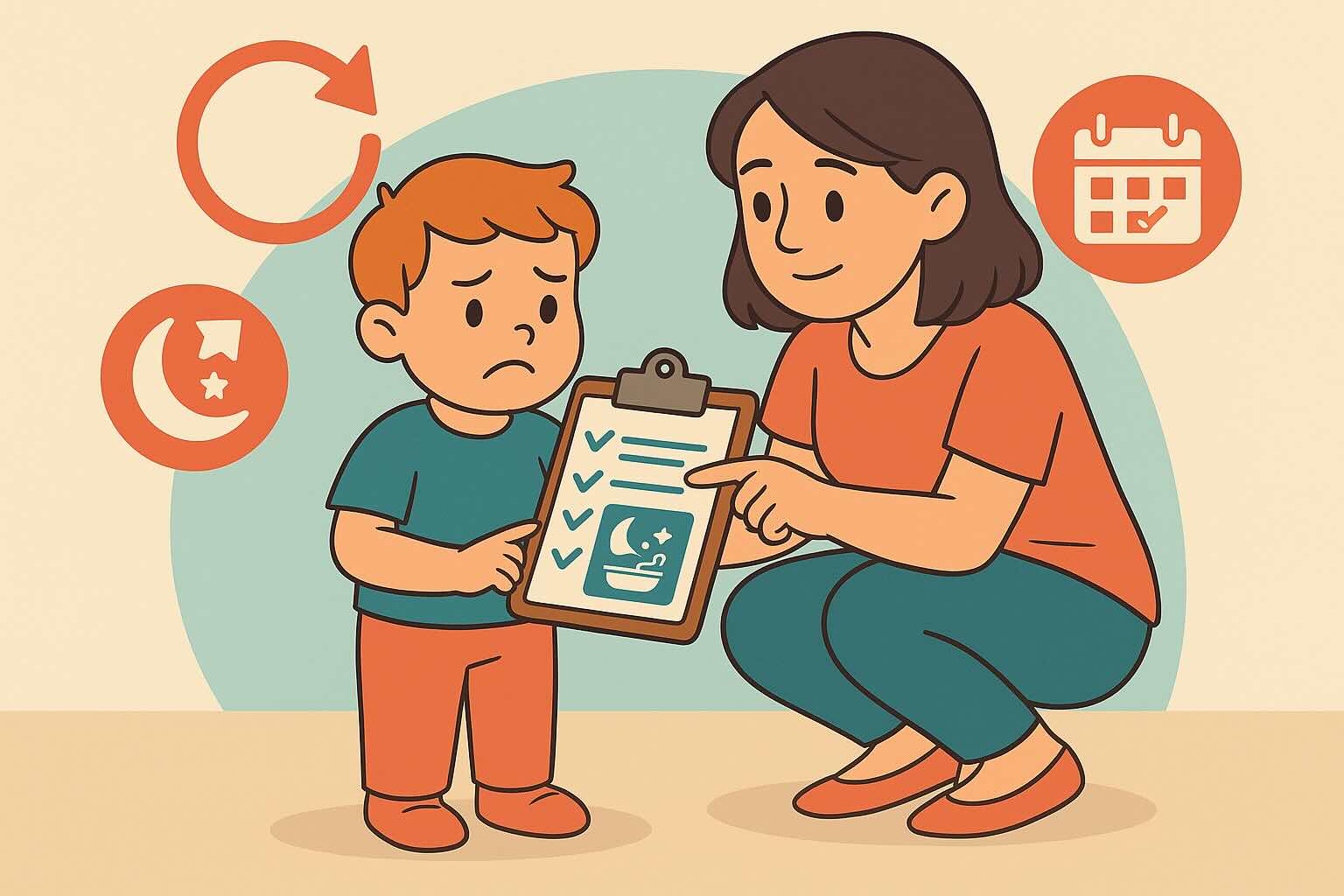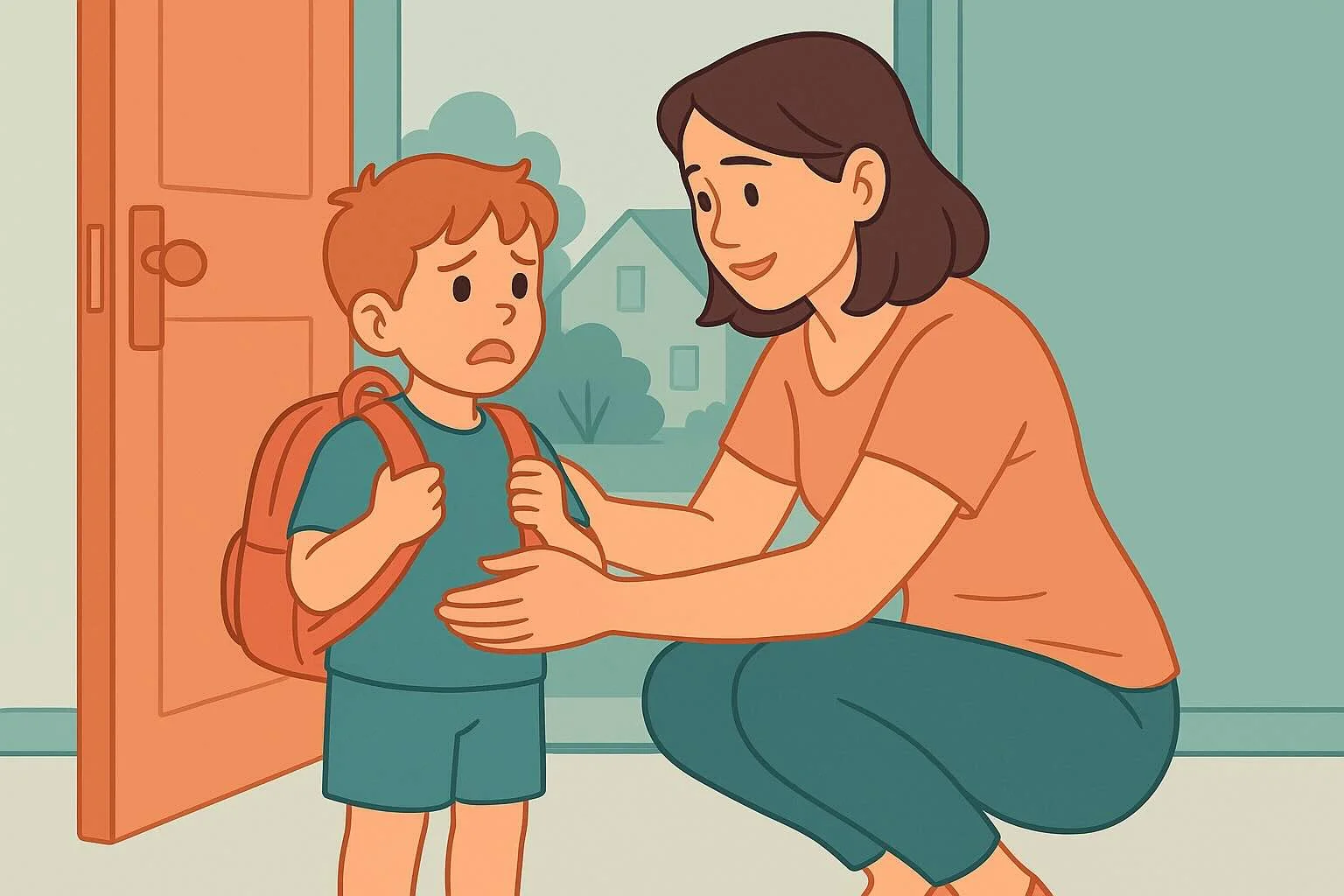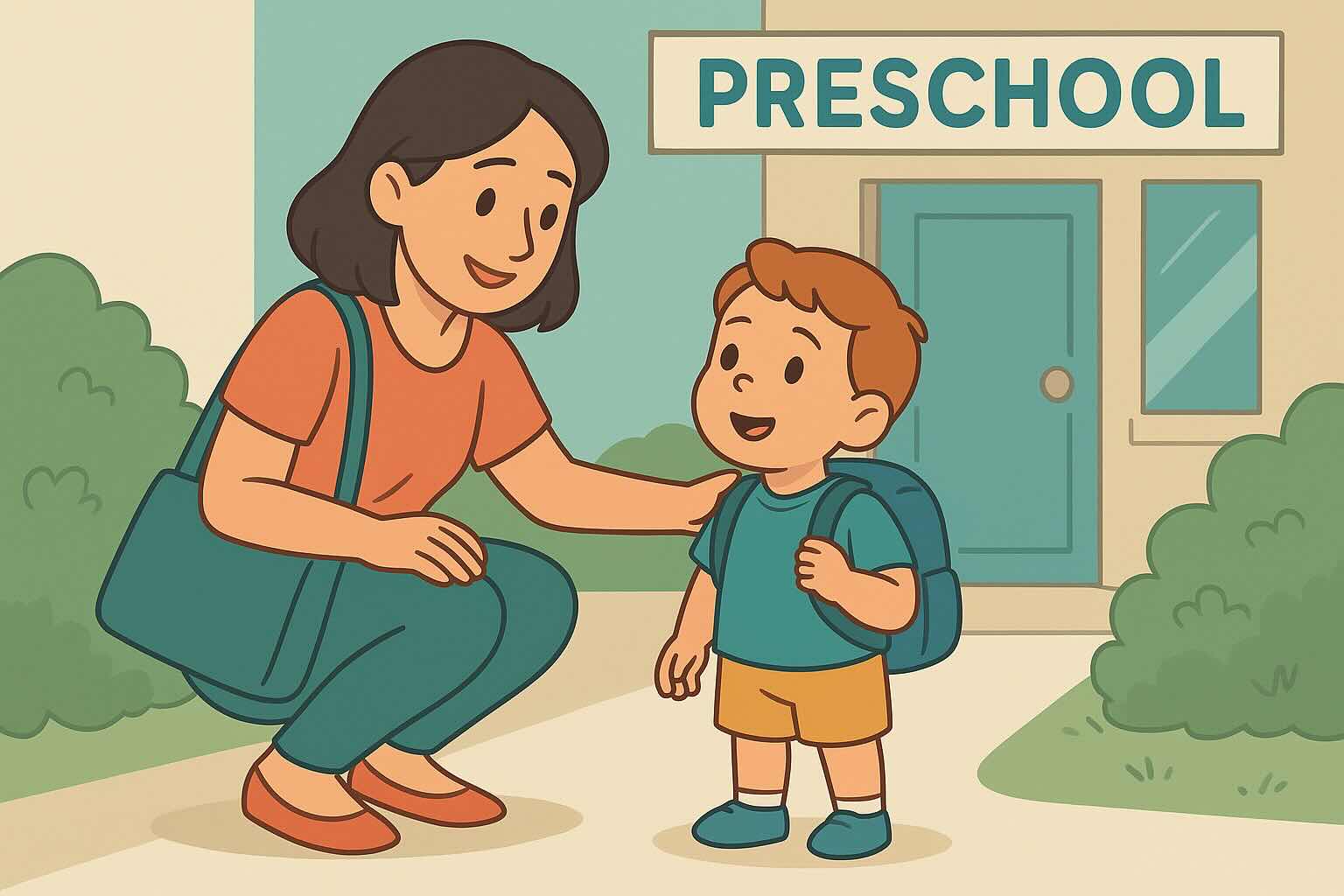Changing Daily Routines: 9 Steps That Prevent Meltdowns and Resistance


From starting school to summer schedule shifts, changing daily routines is an inevitable part of family life—but it doesn't have to trigger family chaos. Research shows that 75% of children experience behavioral changes when routines shift, but families who use gradual, purposeful transition strategies report 60% fewer daily conflicts within 3-4 weeks.
This comprehensive guide provides evidence-based strategies from developmental psychology and family systems research. You'll learn how to transform routine changes from sources of stress into opportunities for growth and improved family functioning.
For related challenges, also check out our moving with children guide, starting school preparation, new sibling transitions, and family visit planning for other major transitions.
What You'll Learn in This Guide
- The Science of Routine and Change - Why routines matter for child development and why changes feel difficult
- The 4-Week Transition Method - Step-by-step approach for implementing routine changes successfully
- Age-Specific Strategies - Different techniques for 3-year-olds vs. 7-year-olds
- Common Routine Change Scenarios - School schedules, daylight saving time, work changes, and seasonal shifts
- Resistance Management Techniques - How to handle pushback, meltdowns, and regression during transitions
- Family System Considerations - Coordinating changes across multiple caregivers and family members
- Real Family Routine Success Stories - How other families navigated challenging schedule transitions
Estimated reading time: 10 minutes
The Science Behind Routines and Why Changes Feel Hard
Why Children Need Predictable Routines
Routines serve crucial developmental functions:
- Emotional regulation: Predictable sequences help children manage transitions and emotional states
- Cognitive development: Knowing what comes next frees mental energy for learning and growth
- Security and attachment: Consistent patterns create feelings of safety and stability
- Independence building: Familiar routines allow children to take ownership of their daily activities
- Family connection: Shared routines create belonging and family identity
The Neuroscience of Routine Disruption
When routines change, children's brains must work harder to process new information and create new neural pathways. This increased cognitive load can manifest as:
Normal responses to routine changes:
- Increased fatigue and irritability
- Resistance to new patterns even when they're objectively better
- Temporary regression in behavior or skills
- Need for more emotional support and reassurance
- Testing boundaries to reestablish predictability
- Sleep or appetite disruptions during adjustment period
These responses are protective mechanisms, not signs of defiance or poor adaptation.
Individual Differences in Routine Flexibility
Naturally adaptable children may adjust to new routines within 1-2 weeks and show curiosity about changes.
Routine-dependent children may need 4-6 weeks and benefit from extensive preparation and gradual transitions.
Sensitive children might experience stronger stress responses but adapt well with adequate emotional support.
Consider your child's temperament when planning timeline and support strategies.
The 4-Week Routine Transition Method
Week 1: Preparation and Introduction
Assess current routine effectiveness:
- Identify what's working well and what needs improvement
- Note your child's natural rhythms and energy patterns
- Determine which changes are necessary vs. desired
- Evaluate family stress points and daily conflicts
Begin conversations about upcoming changes:
- "We're going to try a new way of doing [specific routine] to help our family."
- "Change can feel hard at first, and that's normal."
- "We'll practice together until the new way feels familiar."
Involve your child appropriately:
- Let them help plan age-appropriate elements
- Show them visual schedules or charts for new routines
- Practice pieces of the new routine during calm moments
- Answer questions and address concerns about changes
Week 2: Gradual Implementation
Start with one routine element at a time:
- Implement the easiest or most necessary change first
- Maintain familiar elements while introducing new ones
- Use visual cues (timers, charts, pictures) to support transitions
- Practice new routines at non-stressful times when possible
Support your child's adjustment:
- Acknowledge difficulty: "This new routine feels different, doesn't it?"
- Celebrate small successes: "You remembered to brush your teeth first!"
- Maintain patience with resistance and mistakes
- Stay consistent even when it feels harder than the old way
Week 3: Consistency and Refinement
Focus on consistent implementation:
- Follow the new routine even on difficult days
- Coordinate with all caregivers to maintain consistency
- Make minor adjustments based on what you've learned
- Continue using visual supports and reminders
Address ongoing resistance:
- Validate feelings while maintaining the routine
- Look for patterns in when resistance is strongest
- Provide extra emotional support during difficult transitions
- Remind your child (and yourself) that adjustment takes time
Week 4: Stabilization and Integration
Evaluate routine effectiveness:
- Note improvements in family functioning and child cooperation
- Identify any elements that need further adjustment
- Celebrate successful adaptation and family teamwork
- Plan for maintaining consistency during disruptions (weekends, vacations)
Build routine ownership:
- Encourage your child to remind family members about routine steps
- Let them help teach the routine to visiting relatives or babysitters
- Create routine ownership through special jobs or responsibilities
- Acknowledge their adaptation and growth
Age-Specific Routine Change Strategies
Ages 3-4: Concrete Thinking and Visual Support
Developmental considerations:
- Limited understanding of time concepts and future planning
- High need for visual and sensory cues
- Difficulty with abstract explanations of why changes are necessary
- Strong attachment to familiar patterns and objects
Effective strategies:
- Use picture schedules showing each step of new routines
- Practice new routines with dolls, stuffed animals, or role-play
- Maintain consistent timing even if content changes
- Use special objects or music to signal new routine elements
- Keep explanations simple: "First we do this, then we do that"
Common challenges:
- Forgetting new routine steps and needing frequent reminders
- Emotional outbursts when familiar routines change
- Difficulty understanding why old routines can't continue
- Need for patient repetition and physical guidance
Ages 4-5: Growing Independence and Helper Motivation
Developmental readiness:
- Better understanding of time sequences and cause-effect relationships
- Desire to be helpful and take on new responsibilities
- Growing ability to remember and follow multi-step instructions
- Pride in mastering new skills and routines
Preparation strategies:
- Explain simple reasons for routine changes they can understand
- Create special jobs or responsibilities within new routines
- Use timers and countdowns to help with time awareness
- Let them help create visual schedules or routine charts
- Practice routine changes as "games" or "challenges"
Common concerns:
- Questions about fairness if routines differ from siblings or friends
- Worry about making mistakes in new routines
- Desire for control over some routine elements
- Balancing independence with need for guidance
Ages 5-7: Logical Thinking and Responsibility
Advanced capabilities:
- Understanding of complex cause-effect relationships
- Ability to participate in routine planning and problem-solving
- Awareness of family needs beyond their own preferences
- Capability for self-monitoring and routine ownership
Collaboration strategies:
- Include them in family discussions about routine needs and goals
- Explain how routine changes benefit the whole family
- Give them meaningful input on timing and implementation
- Teach them to use clocks and schedules independently
- Create systems for them to track their own routine success
Unique considerations:
- Understanding of family stress and external pressures affecting routines
- Ability to compare family routines to those of friends or extended family
- Desire for logical explanations and fair implementation
- Capacity to help younger siblings with routine changes
Common Routine Change Scenarios
School Schedule Transitions
Summer to school year:
- Begin shifting bedtime and wake-up time 2-3 weeks before school starts
- Practice morning routines including getting dressed and eating breakfast
- Gradually introduce structured activities and learning time
- Prepare school supplies and create designated homework spaces
Holiday breaks and returns:
- Maintain some school-year structure during breaks while allowing flexibility
- Begin transitioning back to school schedule 1 week before return
- Address anxiety about routine changes and academic expectations
- Plan special activities that bridge holiday fun with school responsibilities
Daylight Saving Time and Seasonal Changes
Time changes:
- Adjust schedules gradually over 3-4 days rather than immediately
- Move bedtime and wake-up time by 15-20 minutes each day
- Maintain consistent meal timing to support circadian rhythm adjustment
- Use natural light exposure to help with time transition
Seasonal activity shifts:
- Prepare children for weather-related routine changes
- Adjust outdoor activity timing based on daylight and temperature
- Modify clothing routines for seasonal weather needs
- Plan indoor alternatives for weather-dependent activities
Work and Family Schedule Changes
Parent work schedule changes:
- Discuss changes in age-appropriate terms focusing on family adaptation
- Maintain consistent child routines even if parent schedules shift
- Coordinate with childcare providers about routine consistency
- Plan special connection time that accommodates new work demands
Childcare transitions:
- Provide new caregivers with detailed routine information
- Allow transition time for children to adapt to different routine styles
- Maintain core routine elements while allowing flexibility in implementation
- Communicate regularly with caregivers about child's adjustment
Managing Routine Change Resistance
The ADAPT Method for Handling Pushback
A - Acknowledge the Difficulty "Change is hard. It's normal to feel frustrated when routines are different." "I know this new way feels strange compared to what we used to do." "Your feelings about this change make sense—it's a big adjustment."
D - Describe the Plan "Here's what we're going to do: [specific, simple steps]." "We've planned this change to help our family [specific benefit]." "This is our new routine, and we're going to practice it together."
A - Allow for Adjustment Time "Learning new routines takes time—it's okay if it feels hard at first." "We'll keep practicing until it feels normal and easy." "Some days will be easier than others, and that's expected."
P - Provide Support "I'll help you remember the new steps until you know them well." "We can use [visual aids/reminders] to help with the new routine." "I'm here to answer questions and help when things feel difficult."
T - Trust the Process "Even though it's hard now, new routines get easier with practice." "Let's give this [specific time period] to see how it works for our family." "We can make small adjustments, but we're going to keep the main changes."
Specific Resistance Scenarios
"I don't want to do the new routine!"
- Validate the feeling: "You wish things could stay the same."
- Maintain the boundary: "AND this is our new routine."
- Offer support: "I'll help you until it feels easier."
"The old way was better!"
- Acknowledge their perspective: "You really liked how we used to do things."
- Explain without over-justifying: "We changed because [simple reason]."
- Focus forward: "Let's figure out how to make the new way work well too."
Physical resistance or meltdowns:
- Stay calm and consistent with the routine
- Ensure safety without forcing compliance
- Offer comfort after the storm passes
- Return to the routine once emotions have regulated
When to Adjust vs. Stay Consistent
Signs a routine change needs modification:
- Consistent implementation for 3-4 weeks with no improvement
- Routine creates safety concerns or family distress
- Change conflicts with child's natural rhythms or developmental needs
- Multiple family members unable to maintain consistency
Signs to stay the course:
- Gradual decrease in resistance over time
- Some days easier than others (normal adjustment pattern)
- Child's basic needs (sleep, nutrition, safety) are being met
- Overall family functioning improving despite initial difficulty
Family System Coordination
Multi-Caregiver Consistency
Essential coordination elements:
- Core routine timing and sequence
- Non-negotiable safety and health elements
- Transition cues and support strategies
- Response to resistance and behavioral challenges
Flexible implementation areas:
- Specific activity content within routine slots
- Individual caregiver interaction styles
- Minor timing adjustments based on circumstances
- Reward systems and motivation techniques
Sibling Considerations
When routine changes affect multiple children:
- Consider each child's developmental needs and capabilities
- Explain why routines might be different for different ages
- Maintain fairness in attention and support during transitions
- Use older children as routine helpers when appropriate
Managing different adjustment timelines:
- Expect siblings to adapt at different rates
- Avoid comparing children's adaptation speeds
- Provide individual support based on each child's needs
- Celebrate each child's progress independently
Real-Life Routine Change Success Stories
The Johnson Family: Conquering Chaotic Mornings
"Our mornings were a disaster—constant rushing, yelling, and everyone starting the day stressed. With two kids ages 4 and 6, getting everyone ready for school and work felt impossible. We used the 4-week method to completely overhaul our morning routine. Week 1, we involved the kids in planning and made visual charts. Week 2, we started waking up 20 minutes earlier and doing clothes/backpack prep the night before. Week 3 was about consistency even when we didn't feel like it. By week 4, mornings actually felt peaceful! The key was making small changes and getting the kids excited about being 'morning success experts.'"
The Martinez Family: Adjusting to Mom's New Work Schedule
"When I started a new job that required me to leave for work an hour earlier, our whole family routine fell apart. My 5-year-old daughter Sofia was used to me handling her entire morning routine, and suddenly dad had to take over. We spent two weeks preparing: dad practiced the routines with me there, Sofia helped create a special 'daddy morning' chart, and we made the handoff feel special rather than sad. The first few mornings had tears, but within three weeks, Sofia was proud of her independence and special time with dad. Now she brags about being able to do her morning routine with either parent."
The Kim Family: Transitioning from Summer to School Schedule
"After a relaxed summer schedule, getting our 6-year-old son ready for first grade felt overwhelming. He'd been going to bed at 9 PM and sleeping until 8 AM all summer, but school required 7:30 AM wake-up. We started the transition three weeks before school: moving bedtime back by 15 minutes every few days, introducing quiet 'learning time' in the afternoons, and practicing the full school morning routine. By the time school started, he was already used to the schedule. The gradual approach made all the difference—no shock to his system or major behavioral issues."
Your 2-Week Quick-Start Routine Change Plan
Days 1-3: Assessment and Planning
- Identify specific routine elements that need to change
- Note your child's current patterns and resistance points
- Create simple visual supports (charts, pictures, schedules)
- Begin conversations about upcoming changes
Days 4-7: Preparation and Practice
- Practice new routine elements during calm, non-rushed times
- Involve your child in preparing visual aids and planning
- Address questions and concerns about changes
- Set implementation start date and prepare family members
Days 8-14: Implementation and Support
- Begin new routine consistently across all caregivers
- Use visual cues and reminders to support memory
- Validate difficulty while maintaining consistency
- Track progress and celebrate small successes
Ongoing: Refinement and Maintenance
- Continue routine for at least 3-4 weeks before making major adjustments
- Monitor family stress and child adjustment indicators
- Make minor tweaks based on what you learn
- Plan for maintaining routines during disruptions (travel, illness, visitors)
Building Long-Term Routine Success
Teaching Routine Flexibility
Help children understand that routines are tools for family functioning, not rigid rules that never change:
- "Routines help our family work well together."
- "Sometimes we need to adjust routines when our needs change."
- "Being flexible with routines is a grown-up skill we can practice."
Creating Family Routine Ownership
Involve children in routine evaluation and improvement:
- Regular family meetings about what's working and what isn't
- Child input on minor routine adjustments and improvements
- Opportunities for children to lead certain routine elements
- Recognition of children's adaptation and growth
Preparing for Future Changes
Build change resilience through successful routine transitions:
- Reference past successful routine changes during new transitions
- Develop family language and strategies for handling change
- Create predictable processes for implementing routine adjustments
- Celebrate family adaptability and problem-solving skills
Key Takeaways: Your Routine Change Success Guide
- ✅ Routine changes affect 75% of children behaviorally but adaptation occurs within 2-4 weeks
- ✅ Gradual implementation works better than sudden changes for most families and children
- ✅ Visual supports and child involvement reduce resistance and increase cooperation
- ✅ Consistency across caregivers is more important than perfection in routine execution
- ✅ Normal adjustment includes temporary regression and increased emotional needs
- ✅ Age-appropriate preparation and explanation improve acceptance of necessary changes
- ✅ Family stress decreases significantly once new routines become established patterns
- ✅ Building routine flexibility helps children adapt to future life transitions
- ✅ Successful routine changes strengthen family problem-solving and adaptability skills
Remember: Changing routines is a family learning process. With patience, preparation, and realistic expectations, routine changes can improve daily functioning and teach valuable adaptation skills.
This article is based on developmental psychology research and family systems studies. Individual experiences vary significantly based on child temperament, family circumstances, and implementation consistency. Always consider your family's unique needs when planning routine changes, and consult with pediatricians if routine disruptions significantly impact your child's wellbeing.
24/7 AI Parenting Assistant
Get instant, personalized advice with expert-curated parenting knowledge. Chat with your AI coach anytime, anywhere.

Routine Transition Planner
4-week method for implementing routine changes successfully with gradual strategies and resistance management techniques.
Frequently Asked Questions
Need personalized support?
RootWise's AI coach can provide tailored strategies for your specific situation, available 24/7 when you need it most.
Learn More About AI Coaching →



